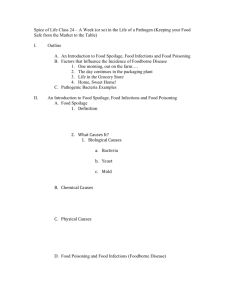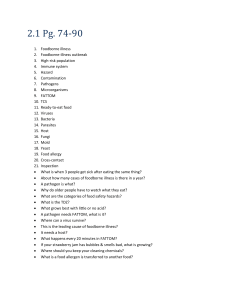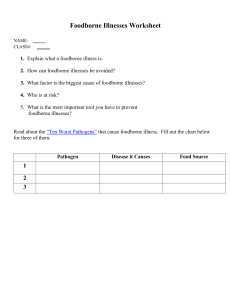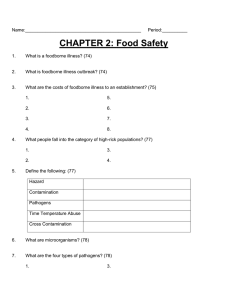Food Microbiology: Preservation & Foodborne Diseases
advertisement
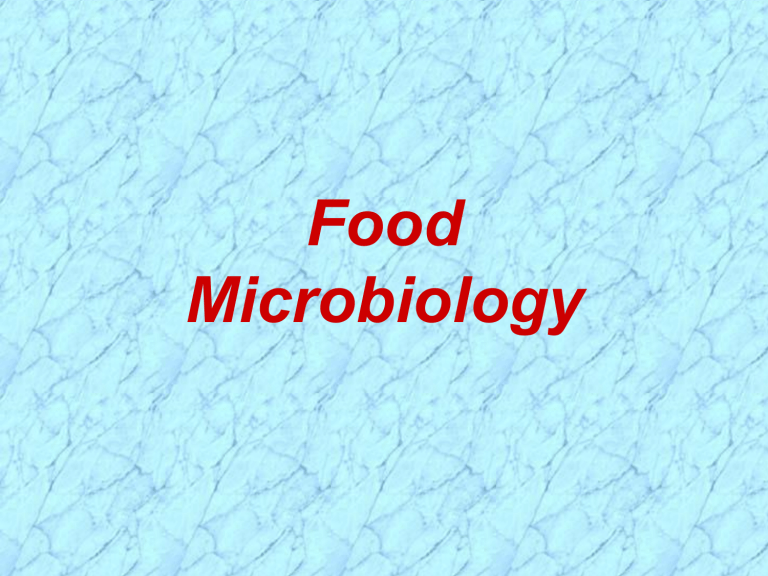
Food Microbiology Food Preservation and Microbial Growth Microbial Growth and Food Spoilage 1. Foods often spoil due to growth of contaminating microorganisms. 2. Foods vary considerably in their sensitivity to microbial growth, depending on their: nutrient content water availability (known as water activity, aw) pH. 3. Perishable and semiperishable foods have limited shelf life due to spoilage. 4. Nonperishable (stable) foods have an extended shelf life and are resistant to spoilage by microorganisms. 5. A variety of microorganisms induce food spoilage, and although most are not, some food spoilage microorganisms are also potential pathogens. Food Preservation 1. Food microbiology deals with methods for limiting spoilage & the growth of disease-causing microorganisms in food during processing & storage. 2. The earliest methods of preserving foods included: drying addition of salt or sugar fermentation. 3. The growth of microorganisms in perishable foods can be controlled by: refrigeration or freezing lyophilization (freeze-drying) pasteurization canning fermentation or pickling dehydration chemical preservatives irradiation. Aseptic Packaging Presterilized materials are assembled into packages and aseptically filled with heat-sterilized liquid foods. Radiation and Industrial Food Preservation Gamma radiation can be used to sterilize food, kill insects and parasitic worms, and prevent the sprouting of fruits and vegetables. Irradiation logo (radura) Isn’t it friendly??? The intent? To avoid consumer images of Three Mile Island or Chernobyl or Fukushima!! Foodborne Diseases Manifestations and Causes of Foodborne Illnesses 1. The majority of cases of foodborne disease manifest as gastroenteritis, most commonly with diarrhea and/or nausea and vomiting, but many other signs and symptoms are possible, depending on the infecting agent. 2. More than 200 different infectious agents, including bacteria, viruses, protozoa and even prions can cause foodborne disease. 3. Viruses cause the vast majority of foodborne illnesses. Noroviruses (previously Norwalk and Norwalk-like viruses) are the most common foodborne pathogens, causing more than 9 million cases per year in the USA. Foodborne Disease vs. Food Poisoning Introduction and Clarification 1. Foodborne diseases include intoxications and foodborne infections. An intoxication is a disease caused by the ingestion of a pre-formed toxin already present in food. A foodborne infection is established after ingesting food containing pathogens that must first colonize and multiply before virulence factors, which may include toxins, mediate foodborne disease. IMPORTANT NOTE: Depending on the text that you consult, there are differences in how food poisoning is defined. 2. For our purposes, we will define food poisoning as an intoxication. A Single Virus is Responsible for Vast Majority of Foodborne illnesses Noroviruses (previously Norwalk and Norwalk-like viruses) are the most common foodborne pathogens, causing more than 9 million cases per year in the USA. Noroviruses are associated with large scale outbreaks (e.g., cruise ships, hotels, etc.) Virus remains infectious for long periods of time on surfaces Following an outbreak, every surface from floor to ceiling must be disinfected Staphylococcal Food Poisoning 1. Staphylococcal intoxication results from the ingestion of preformed enterotoxin produced by Staphylococcus aureus. S. aureus contaminates foods that are generally high in protein content. Staphylococcal enterotoxin is a superantigen 2. In many cases, S. aureus cannot be cultured from the contaminated food. Clostridial Food Poisoning and Botulism 1. The spore-forming bacterium, Clostridium perfringens can cause food poisoning from ingestion of toxins (intoxication) Quite common Usually self-limiting gastrointestinal disease associated with consumption of contaminated meat. 2. Botulism (Clostridium botulinum) is a rare but very serious disease with significant mortality due to a potent neurotoxin produced by microbial growth in foods or by microbial growth and toxin production in the body. Sporadic cases are often associated with home canning. Bacillus cereus Food Poisoning & Foodborne Infection Bacillus cereus causes two clinical types of foodborne disease. Emetic (vomiting) form of gastroenteritis is an intoxication usually associated with consumption of improperly refrigerated rice. Toxin is heat stable, so re-heating does not protect Diarrheal form of gastroenteritis is usually associated with an infection from consumption of contaminated meat or vegetables. Campylobacteriosis 1. Campylobacter infection was the most prevalent foodborne bacterial disease 2. Most cases are associated with improperly prepared poultry. 3. Campylobacteriosis affects nearly 2 million people per year in the USA 4. Usually a self-limiting gastroenteritis, 5. Infection with certain serotypes of Campylobacter may predispose certain individuals to Guillain-Barre syndrome (GBS), an autoimmune disorder of the peripheral nervous system. Salmonellosis (Non-typhoidal disease) 1. There are >1.3 million cases of salmonellosis every year in the U.S. 2. Most cases are associated with consumption of improperly prepared poultry or raw eggs (e.g., Caesar salad) 3. The disease results from infection with ingested Salmonella introduced into the food chain from food production animals or food handlers. Prevalence of salmonellosis in the USA Escherichia coli Gastroenteritis 1. Most Escherichia coli are opportunistic pathogens, but some strains are true pathogens and can cause serious foodborne diseases. Enterotoxigenic E.coli (ETEC) causes most cases of traveller’s diarrhea. Enterohemorrhagic E. coli (EHEC) (e.g., E. coli O157:H7) is associated with undercooked ground beef and can cause hemolytic uremic syndrome (HUS) and death in at-risk individuals. Enteropathogenic E. coli causes infant diarrhea in underdeveloped countries. 2. Large-scale processing methods for meats and meat products allow contaminants from a small number of individual carcasses to contaminate or infect large numbers of products. 3. Specific measures, such as radiation of ground beef, have been implemented to curb the spread of these pathogens. Listeriosis 1. Listeria monocytogenes is an environmentally ubiquitous microorganism that is found occasionally as a contaminant of: soft cheeses luncheon meats hot dogs. 2. Large-scale food recalls are not uncommon. 3. Listeria is one of the few pathogens that can multiply at refrigerator temperatures (4oC). 4. In normal individuals, Listeria seldom causes infection. 5. In immunocompromised individuals or pregnant women, Listeria can cause serious disease and even death. Common Diseases that may be both Water and Foodborne Shigellosis (Bacillary Dysentery) 1. Water and foodborne disease, also known as bacillary dysentery Cramping and diarrhea, often with blood and mucus Frequent, low-volume stools Straining to defecate, called tenesmus 2. Fecal-oral transmission 3. Humans are primary reservoir, most commonly fecal contamination of water sources or unsanitary practices by food handlers 4. Extremely low infectious dose; < 100 bacterial cells can cause disease 5. Common sources include: Fecally-contaminated water Salads Raw vegetables Milk, dairy, and poultry. 6. The genus Shigella has only four species Typhoid Fever 1. Water and foodborne disease caused by Salmonella typhi, but quite unique from ‘garden-variety’ salmonellosis 2. Caused by fecal-oral transmission by human carriers Typhoid Mary was first recognized human carrier In about 1 of every 20 cases, the organisms colonize the gallbladder which serves as the reservoir Organisms move through the biliary duct into the small intestine and are shed in feces 3. 10-14 day incubation period with Initial signs of sepsis/bacteremia as organisms goes systemic Prolonged fever with delirium for > one week Returns to intestine via gallbladder with abdominal pain and gastrointestinal symptoms 4. Humans are primary reservoir, most commonly fecal contamination of water sources or food via unsanitary practices by food handlers that are carriers Cholera 1. Water and foodborne disease, caused by Vibrio cholerae Frequent epidemics and pandemics from fecal-oral transmission Often associated with poor public health and sanitation Easily treatable, but often goes untreated leading to death in 10-30% of untreated cases 2. 2-3 days after ingestion of vibrios, about 20% of infected cases have an abrupt onset of Vomiting Severe, life-threatening, watery diarrhea Patients may lose 15-20 liters (~4-5 gallons) of fluid per day Stool becomes colorless, odorless, and devoid of protein and is referred to as rice-water stool Stool may be ‘flecked’ with mucus Loss of fluids and electrolytes leads to death by Hypovolemic shock (low blood volume) Metabolic acidosis (due to loss of buffering capacity) 3. Other vibrios, Vibrio vulnificus and Vibrio parahaemolyticus cause serious disease or even death from consumption of contaminated shellfish or raw fish Additional Material Food Preservation and Microbial Growth Gamma-ray irradiation facility Industrial Food Canning 1. Commercial sterilization heats canned foods to the minimum temperature necessary to destroy endospores of Clostridium botulinum while minimizing alteration of the food. Sufficient heat to reduce a population of C. botulinum by 12 logarithmic cycles (12D treatment). Endospores of thermophiles can survive commercial sterilization. 2. Canned foods stored above 45°C can be spoiled by thermophilic anaerobes. Thermophilic anaerobic spoilage may be accompanied by gas production If no gas is formed, the spoilage is called flat sour spoilage. 3. Spoilage by mesophilic bacteria is usually from improper heating procedures or leakage. 4. Acidic foods can be preserved by heat of 100°C because microorganisms that survive are not capable of growth in a low pH. Acid-tolerant and heat-resistant microbes can spoil acidic foods. Byssochlamys, Aspergillus, and Bacillus coagulans Construction of a metal can Commercial sterilization process in industrial canning Commercial sterilization of food is accomplished by steam under pressure in a retort. The Role of Microorganisms in Food Production Mushrooms 1. The most important food produced from a microorganism is the mushroom which are any of a variety of fungi of the order Agaricalles. Edible mushrooms are fleshy, umbrella-shaped fruiting bodies of the fungus. Poisonous species are properly called toadstools. 2. The study of fungi is called mycology. Fermented Foods Microbial fermentation is an important process used to produce, preserve and/or enhance a number of foods, including: breads dairy products meats and vegetables alcoholic beverages vinegar and other organic acids sauerkraut, pickles, olives and soy sauce. Nondairy Fermentations 1. Sugars in bread dough are fermented by yeast to ethanol and C02 C02 causes the bread to rise and produces the “holes” in the bread. 2. Sauerkraut, pickles, olives, and soy sauce are the products of microbial fermentations. Cheese 1. The milk protein casein curdles because of the action by lactic acid bacteria or the enzyme rennin or chymosin. The growth of microorganisms in cheeses is called ripening. 2. Cheese is the curd separated from the liquid portion of milk, called whey. Hard cheeses are produced by lactic acid bacteria growing in the interior of the curd. Semisoft cheeses are ripened by bacteria growing on the surface Soft cheeses are ripened by Penicillium growing on the surface. Other Dairy Products 1. Old-fashioned buttermilk was produced by lactic acid bacteria growing during the butter-making process. 2. Commerical buttermilk is made by letting lactic add bacteria grow in skim milk for 12 hours. 3. Sour cream, yogurt, kefir, and kumiss are produced by lactobacilli, streptococci, or yeasts growing in low-fat milk. Alcoholic Beverages and Vinegar 1. Carbohydrates obtained from grains, potatoes, or molasses are fermented by yeasts to produce ethanol and CO2 in the production of beer, ale and distilled spirits. Beer is made from fermentation of malted grain (brewing). Distilled beverages are made from distillation of fermented solutions. 2. The sugars in fruits such as grapes are fermented by yeasts to produce wines. In wine-making, lactic acid bacteria convert malic acid into lactic acid in malolactic fermentation in fruits with high acidity. 3. Acetic acid (vinegar), an organic acid, oxidized from ethanol in fruit juice/wine by Acetobacter and Gluconobacter. Adequate aeration is the most important consideration in ensuring a successful vinegar process. Basic steps in red winemaking Citric Acid and Other Organic Compounds 1. A number of organic chemicals are manufactured commercially using fermentation by microorganisms. 2. Citric acid is an economically important product of the Aspergillus niger fungus, which, in the absence of iron, overproduces citric acid as a chelator to scavenge iron. Over 550,000 tons of citric acid are produced per year worldwide with a total value of $1 billion U.S. Historically, lessons learned from perfecting citric acid fermentation were applied to penicillin and other antibiotic fermentations. Citric acid is commonly used as an antioxidant & flavoring agent in beverages, confectionaries & other foods and as a leavening agent in bread. 3. Lactic acid, used to acidify foods and beverages, is fermented by various types of lactic acid bacteria. 4. Sorbose, used in the manufacture of ascorbic acid (vitamin C), is produced when Acetobacter oxidizes sorbitol. Citric acid fermentation Sucrose is converted to glucose and fructose by the enzyme sucrase. As the Aspergillus niger culture reaches stationary phase, these sugars are converted to citric acid, a secondary metabolite, to scavenge iron. Yeast as a Food and Food Supplement 1. Yeast cells are grown for use in the baking and food industries. 2. Commercial yeast is produced in large-scale aerated fermentors using molasses as the main carbon and energy source. Foodborne Diseases Foodborne Disease: Infection vs. Intoxication Introduction and Clarification 1. Foodborne diseases include foodborne intoxications and foodborne infections. Depending on the text that you consult, there are differences in how food poisoning is defined. Some textbooks consider food poisoning the result of ingesting microbial toxins or microorganisms that produce toxins. This interpretation is problematic in that: i) many microorganisms that are ingested, establish an infection and cause disease by producing toxins and/or other virulence factors ii) an infection, by definition, is colonization and/or invasion with multiplication of a pathogen with or without disease. 4. For our purposes, we will define food poisoning as an intoxication. An intoxication is a disease caused by the ingestion of a pre-formed toxin already present in food. Thus, food poisoning is one form of foodborne disease, but the ingestion of pathogens in/on food that must first establish an infection to cause foodborne disease, whether or not they do so by the production of toxin(s), we will not consider to be food poisoning. FP = foodborne intoxication FI = nonintoxication foodborne disease Learning Objectives 1. Describe thermophilic anaerobic spoilage and flat sour spoilage by mesophilic bacteria. 2. Compare and contrast food preservation by industrial food canning, aseptic packaging, and radiation. 3. Name four beneficial activities of microorganisms in food production.
